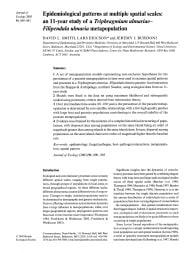May 27, 2010

- A set of metapopulation models representing non-exclusive hypotheses for the persistence of a parasite metapopulation in time were used to examine spatial patterns and processes in a Triphragmium ulmariae–Filipendula ulmaria parasite–host interaction from the Skeppsvik Archipelago, northern Sweden, using ecological data from an 11-year study.
- Models were fitted to the data set using maximum likelihood and subsequently ranked using parsimony criteria derived from information theory.
- Over intermediate time-scales (10–100 years), the persistence of the parasite metapopulation is determined by core-satellite relationships, with a few high-quality patches with large host and parasite populations contributing to the overall stability of the parasite metapopulation.
- Evidence was obtained for the existence of a complex hierarchical structuring of populations, with dispersal rates among populations on the same island being an order of magnitude greater than among islands in the same island chain. In turn, dispersal among populations on the same island chain were orders of magnitude higher than the baseline rate.

